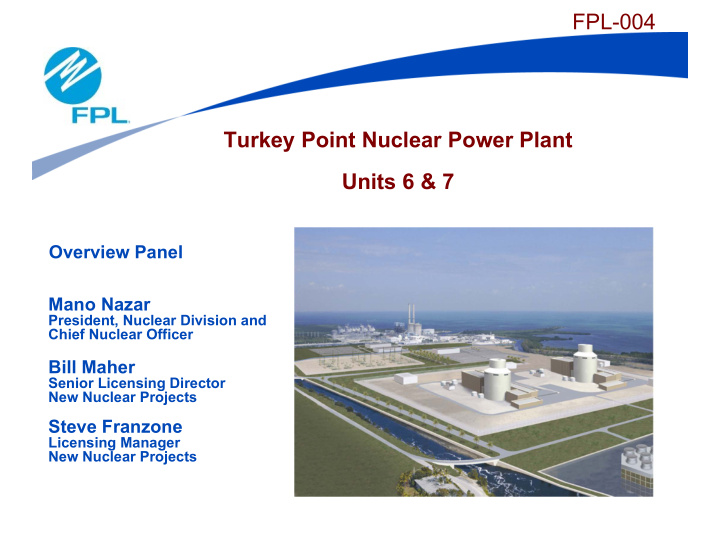



FPL-004 Turkey Point Nuclear Power Plant Units 6 & 7 Overview Panel Mano Nazar President, Nuclear Division and Chief Nuclear Officer Bill Maher Senior Licensing Director New Nuclear Projects Steve Franzone Licensing Manager New Nuclear Projects
FPL Service Territory 2
FPL’s nuclear plants are part of the NextEra Energy fleet. Acquired: 2002 Acquired: 2002 Seabrook Seabrook (New Hampshire) (New Hampshire) 1,100 MW 1 1,100 MW 1 Acquired: 2007 Acquired: 2007 Point Beach Point Beach (Wisconsin) (Wisconsin) 1,190 MW 1,190 MW St. Lucie St. Lucie (Florida) (Florida) 1,821 MW 1 1,821 MW 1 Acquired: 2006 Acquired: 2006 Duane Arnold Duane Arnold Turkey Point Turkey Point (Iowa) (Iowa) (Florida) (Florida) 431MW 1 431MW 1 1,632 MW 1,632 MW The NextEra nuclear fleet is the 4 th largest in the US and represents approximately a quarter of the company’s generation. 1) Capacity based on FPL/NEER ownership shares 3
FPL performed a comprehensive Site Selection Process 4
Turkey Point Site Overview 5
Turkey Point Site Overview The project would be located within the existing industrial wastewater facility that provides cooling for Units 3 & 4 6
The project will use reclaimed water from Miami-Dade County as its primary source of cooling water for electric generation Backup system of radial Reclaimed water collector wells 7
Project takes advantage of existing site attributes with improvements to facilitate construction General Arrangement Construction laydown area 8
Site Plot Plan 9
Turkey Point Units 1 to 5 Units 6 & 7 10
Turkey Point Units 6 & 7 Units 6 & 7 11
Turkey Point Units 6 & 7 COL Application • Combined License Application (COLA) for two units – Submitted June 2009 – Incorporates by Reference the AP1000 Design Control Document (DCD), Rev. 19 – S-COLA adopts the R-COLA resolution of standard plant licensing issues • NRC Guidance Utilized – Regulatory Guide 1.206 “Combined License Applications for Nuclear Power Plants” – NUREG-0800 “Standard Review Plan for the Review of Safety Analysis Reports for Nuclear Power Plants” – NUREG-1555 “Standard Review Plans for Environmental Reviews for Nuclear Power Plants” – RIS 2006-06 “New Reactor Standardization Needed to Support the Design- Centered Licensing Review Approach” Followed design centered working group process throughout review 12
Turkey Point Units 6 & 7 COLA: Exemptions • Two Standard Exemptions – Combined License (COL) Application Organization and Numbering – Special Nuclear Material Control and Accountability (MC&A) Program Description (Consistent with Part 50 requirements) • Five Previously Resolved Generic Issues – Condensate Return Design Change – Main Control Room Dose – Main Control Room Heatup – Combustible Gas Control in Containment – Source Range Neutron Flux Doubling Block Permissive • Turkey Point Site Specific Exemption – Maximum Safety Wet Bulb (noncoincident) Air Temperature 13
Water resource selection was an important project design consideration FPL’s Turkey Point Environmental Stewardship • Use of an existing site • Extensive use of existing transmission corridors • Construction road network restoration • Wetland mitigation projects • Beneficial reuse of reclaimed water • Novel backup water supply using radial collector wells 14
Summary of Environmental Review • Environmental Report (ER) completed in 2009 – Thorough NRC staff audit of ER and alternative site analysis – Public outreach – Consultations with Federal, Tribal, State, and Local Government entities • FEIS published – October 2016 – Performed a comprehensive review of the environmental impacts of Units 6 & 7 as well as mitigation and alternatives – Staff concluded that the COLs should be issued • Contested hearing before ASLB – Reviewed Staff’s consideration of the environmental impacts of liquid effluent injection – ASLB approved the Staff’s treatment of this issue in the FEIS 15
16
Recommend
More recommend